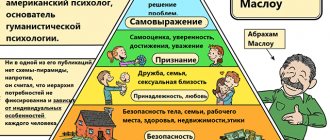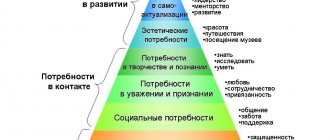Hello, friends. Today we will talk about human needs. Oh, how many things we want at once! Moreover, sometimes desires change literally at the speed of light (this is especially true for the fair half of humanity).
You might be interested
- How to give a client a discount and not go broke?
- Product and its role in marketing
What is Maslow's pyramid
Maslow's pyramid is a description of human needs: from base desires to sublime ones.
Abraham Maslow formulated the theory in 1954 in Motivation and Personality. He structured human desires and needs and created a hierarchy of needs.
Maslow's hierarchy of needs theory
Below is a table describing the levels of the theory of needs from lowest to highest.
| Levels of hierarchy of needs | Definitions | Explanations |
| Physiology | Satisfying the vital functions of the body | Sleep, food, natural needs, health, sex |
| Safety | A sense of security and comfort, protection from external threats and one’s own fears | Strong walls and a roof over your head, home protection from emergencies, home or life insurance |
| Love and Belonging | Communication, affection, family, friendship - socialization | Finding friends and a partner, creating a family, confidence that a person will be understood and accepted for who he is |
| Respect and recognition | The desire to be important and to be recognized in society | Earn more and show your status, achieve success |
| Creativity and cognition | Striving for new knowledge | Travel, second education and seminars, advanced training |
| Aesthetics | Finding harmony and joy through art and beauty | Studying the culture of other countries, going to museums and theaters, creativity and collecting |
| Self-actualization | Search for the meaning of life, rethinking values | Realization of dreams, analysis of spiritual values, self-discovery and talent development |
The classic pyramid looks like this:
Maslow's pyramid. Source
We've loosened up the strict emoji hierarchy a bit so you can easily remember the key points:
Maslow's pyramid - human needs
The essence of the theory
The psychologist examined incentives and motivators, as well as the degree of their satisfaction, which act as a driving force and call to action. He suggested that every person has certain needs for a comfortable life that he strives for.
Maslow formulated several principles characterizing human nature:
- People's needs will never be fully satisfied.
- A state of partial or complete dissatisfaction prompts a person to take action - to look for food, shelter, warmth.
- People's desires follow a hierarchy: from simple to complex.
Requests can be primary and secondary, and in the latter some steps may be skipped. Therefore, the theory is shown in the form of a pyramid rather than a diagram.
A person's primary or physiological needs This is what helps him exist - food, water and movement.
Secondary or psychological motivators come with a person's experience and development: success, respect, power, belonging and the desire for well-being.
It is important to note that until an individual satisfies basic desires: physiological needs according to Maslow and ensuring security, it will be difficult for him to think about higher aspirations.
For example: if you work extremely hard, take care of sick parents and do all the household chores, you have no time to think about self-development and self-knowledge.
Higher needs characterize a person's personality and show a wide range of cultural individual differences, but they are extremely difficult to measure. According to the author of the theory, only 2% of the Earth's population achieves the highest satisfaction - self-actualization. At the same time, Maslow does not idealize such a person - they also have shortcomings, irritability, stubbornness and inattention to others.
Abraham conducted a study and formulated 15 traits that are inherent in a self-actualizing personality:
- Adequate perception of reality - free thinking, independent of stereotypes and prejudices, as well as lack of fear of uncertainty.
- Acceptance of yourself and others . People do not embellish reality and behave naturally.
- Spontaneity and simplicity . A person makes spontaneous decisions, while they are in harmony with his rituals and traditions.
- Service . People are concerned about their life's mission and calling, not about their current situation. They often relate their activities to universal values.
- Detachment, solitude . A person is prone to loneliness and detachment in relation to current events - therefore he calmly endures failures and finds the right solutions in a timely manner.
- Independence and will . People easily accept criticism, take responsibility, recover quickly and have their own point of view on any issue.
- A fresh look . A person is constantly looking for something new in ordinary and familiar things.
- Mystical or higher experiences . A person concentrates on the problem and on his own “I”.
- A sense of identification with humanity . People transfer all the problems of others onto themselves.
- Interpersonal relationships . When communicating with people, an individual does not allow himself to be drawn into a conflict situation and is always committed to positive contact.
- Democratic . Respect for the opponent and his point of view.
- The ability to distinguish means from ends . People are guided by a sense of ethics and moral principles.
- Sense of humor . A person approaches many things with humor - his professional activities, himself and the things around him.
- Creativity . An individual approaches any process from a creative side.
- Controversial attitude towards cultural traditions . A person treats dogmas categorically or chooses something close to himself.
Classification of human needs
In psychology, all human needs are usually divided into three groups. This classification is quite unambiguous, since each group has very specific and obvious criteria. Let's look at each of them in detail.
Biological needs
This category includes basic needs aimed at survival, achieving physical comfort and procreation. It includes:
- delicious food (taste is important to determine freshness and nutritional value);
- clean water to quench thirst;
- comfortable living conditions;
- security and confidence in your future;
- satisfaction of sexual needs.
The listed aspirations are present in all living beings. They were formed evolutionarily to ensure the survival of the population. Essentially, they are all mechanisms that allow a person (or other creature) to survive and achieve “reproductive success” (produce offspring and ensure their survival in the future).
Social needs
Since man is a social being, he has a number of instinctive aspirations aimed at increasing his own importance in society or his group. The most illustrative examples are:
- Self-identification.
A person associates himself with his social group, while striving to recognize himself as an individual with special personal and other qualities. - Self-affirmation.
It is important for any person to be proud of their own actions and achievements, as well as to feel respect from others. - Altruism and passionarity.
Most of us derive pleasure from doing things that benefit other people or society as a whole. At the same time, self-esteem grows even if our contribution goes unnoticed by others, since for an altruist the act itself is important, and not the approval of others.
Spiritual Needs
There is a system of universal spiritual values that most people share in one way or another. We strive for moral and spiritual growth, appreciate beauty, grace of form and harmony, enjoy contemplating objects of art and listening to beautiful music. At the same time, each person has his own taste, so we all like different styles in music and styles in painting. In addition, priorities of spiritual values change throughout life.
Spiritual needs include:
- Self-actualization.
Obtaining new knowledge, expanding the range of interests and hobbies, professional growth, advanced training - these are all natural aspirations for a person who is currently not concerned with satisfying basic biological needs. - Self improvement.
As we grow up, we understand that we like to become better not in order to please someone, but simply to feel our progress. We give up smoking and alcohol, take up sports, begin to maintain a daily routine and control our stress levels. We just like to think that we're getting a little better every day. - Romantic love.
This point could be considered a manifestation of the reproductive instinct, but for us it is something much more. It is very important for us to have a loved one nearby who inspires us and gives us not only sexual but also emotional pleasure.
Spiritual needs, unlike biological and social ones, are present only in humans. Moreover, their list is not just extensive, but almost endless, since each person finds some of his own hobbies that do not have to be shared with someone else. Some people like fishing, some prefer knitting, some watch TV series, some reread The Little Prince for the hundredth time, some adore the sound of pouring rain outside the window, and some experience peace from the echoing the croaking of frogs in a nearby pond.
Advantages and disadvantages
Now let's understand the advantages and disadvantages of Abraham Maslow's theory.
Advantages
- It allowed us to organize needs and explain in simple language what a person needs.
- Was the basis for the creation of theories of motivation.
- It has influenced all areas of human life - it is used both in business and in everyday life.
- Helped me understand people's values.
- Convenient for self-analysis to understand thoughts and desires, as well as structure your goals.
Flaws
- There are no ways to empirically measure the degree of satisfaction, which means the theory cannot be considered evidence-based.
- The pyramid is a simplified system; it is not suitable for everyone; it is necessary to further segment people’s desires.
- The model does not take into account cultural differences and characteristics. Also, due to objective reasons, namely changes in a person’s lifestyle, it is already outdated and requires improvement and updating.
- The theory does not explain how a satisfied need can re-motivate a person.
- The study also does not help in the study of extraordinary actions, namely, it cannot explain their motives.
- According to the theory, a person satisfies desires from the bottom up, but he constantly needs food, which means that there is an inverse relationship.
Application in marketing
In marketing, Maslow's pyramid serves as a starting point for finding target audiences and segmenting them, as well as for market analysis. Based on data received from users, specialists can find out what needs prevail among the target audience.
For example, the user cannot place an order for a long time - perhaps there are some fears - and the specialist needs to be told about the guarantees. Or show the valuable qualities of a product that will help improve its comfort: cooking equipment, an alarm system to protect the home, a Parker pen as an indicator of a person’s success and wealth.
Important! The pyramid is a material for reflection that will help you understand the big picture, but not solve a specific problem.
Thanks to the concept, it is possible to plan long-term goals in order to track the dynamics of changes in the needs of the audience and see their path of interaction with the brand. That is, the company can predict demand, develop a strategy and assess risks. And for each segment, develop a unique offer and a corresponding product.
For example, a consumer is looking for a vacuum cleaner. It follows the classic customer journey:
- The first stage: “Manifestation of need.” It compares the characteristics and cost of the product.
- The second and third are “Interest” and “Research”. After the buyer has become familiar with the brand, he studies the warranty terms and delivery information.
- The fourth is “Purchase”. Purchase of goods.
- Fifth - “Return” or “Manifestation of need”. After the purchase, a person may discover a defect or breakdown - and either the company will solve this problem, or he will continue to search. At all stages, the buyer experiences different needs.
Application in life
As we said above, theory helps you understand yourself - thoughts, desires, values and fears. By analyzing events or actions, you can understand what need needs to be satisfied and what factors prevent this from being done.
A person is also able to analyze other people and understand how to interact with them. This could be supporting a friend or partner in difficult times, observing ethics in business communication, or expressing gratitude to a salesperson in a store.
Why do I even need to know about basic needs, and how will it help me?
Failure to satisfy basic needs leads to the maintenance and activation of maladaptive patterns that begin to control our behavior. Behavior dictated by the schema further interferes with the satisfaction of needs, negatively affects interpersonal relationships, and prevents acting in accordance with internal values. Awareness of basic needs is an important step towards conscious behavior aimed at living a harmonious, satisfying life.
Awareness of basic needs is an important step towards conscious behavior aimed at living a harmonious, satisfying life.
Maslow's pyramid in work and business
People go to work to satisfy physical needs and provide security, in other words, in search of stability. When you can already meet your daily needs, it is time to strive for career growth, success and recognition.
And entrepreneurs, in turn, can analyze the desires of employees and help satisfy them: promote them, increase wages, hold corporate events in the Maldives, open a soup kitchen, provide training. This also includes improving the workflow: connecting automated systems that take over the routine.
Automation of email newsletters
Send chains of trigger messages: welcome, abandoned cart, reactivation, combining email, SMS and web push within one chain.
Set up trigger mailings
Alternative theories
Maslow's concept gave impetus to the development of theories of motivation. In this section we will look at several popular teachings that are also used in business and in life.
You can read more about all the theories in scientific publications, for example, in the book “Fundamentals of Marketing” by American economist and marketer Philip Kotler.
Alderfer's theory
Clayton Alderfer took Maslow's idea and refined it. He combined the needs and created three groups:
- Existence, or the needs of existence . These are physiological needs and safety.
- Relatedness, or communication needs . This category includes a person’s social relationships, his desire for recognition and respect, as well as the need for self-affirmation.
- Growth, or growth needs . Personal development is the desire to learn new things, self-actualize and enjoy life.
The essence of the theory is that there is no hierarchy as such. The movement can be either bottom-up or top-down. It can be depicted as a pyramid or interconnected parameters, as in the screenshot below.
Alderfer's ERG theory
The concept gives scope for the study of human values and expands the boundaries in the knowledge of motivation. It can also be used in business and in life.
McClelland's theory
David McClelland suggested that lower-level needs are always satisfied to some extent, so he focused on higher-level intangible motivations: power, success and belonging.
| Need for power | Need for success | Need for belonging |
| The desire to defend one’s position and not be afraid to take responsibility for the project and team members | A person performs complex tasks or takes on something new that he has not done before | Following social norms. At the same time, the person is afraid that he will be rejected if he makes a mistake |
| Rejoice in victories and maintain a competitive spirit | People accept praise and feedback on their work | Ready to cooperate, help and support |
| Motivate other people | Trying to contain and predict risks | Avoids risky and conflict situations. Afraid of uncertainty |
| Want to control all processes | Desire to demonstrate competence and skill | A person wants to be noticed, listened to and adequately perceive his ideas |
The author of the concept argued that any person has only three needs - regardless of race, gender, age and cultural code. In his opinion, desires and requests are formed through life experience, and are not innate. In fact, this is why McClelland’s work is also called the theory of learned needs.
The theory is used in companies to understand how to better interact with employees and structure business processes.
Herzberg's theory
Frederick Herzberg's two-factor theory focuses on assessing job satisfaction. He studied employee profiles of companies and came to the conclusion that only two factors influence them: motivators and retention, also called hygiene factors.
SScheme of Herzberg's two-factor theory
Main theses of the concept:
- Employees are motivated to work more if they are given interesting projects, thanked, and given opportunities to solve non-standard problems. They are also given more responsibility.
- Employees lose incentive when hygiene factors are not met - low pay, poor working conditions, negative relationships with colleagues or supervisors.
The theory is applied to internal processes in a company in order to understand the needs of employees, help them and build a system of favorable relationships.
Porter-Lawler theory
Lyman Porter and Edward Lawler developed the concept of a comprehensive model of motivation, which includes five variables:
- The effort expended.
- Perceiving the process and tracking how effort and ability affect reward.
- The result obtained.
- Reward.
- Degree of satisfaction.
The essence of the theory is that a person receives a monetary reward for his work and through it satisfies his personal needs.
The main conclusion from the teaching: productive work, which brings reward to a person, generates satisfaction.
Scheme of the Porter-Lawler integrated motivation model
The idea is used in business to evaluate the performance of company employees. Managers, following this model of behavior, must set clear and understandable tasks, monitor their implementation and properly reward employees.
Signs of successful implementation of intentions
You can be sure that everything is going right if a person has the following traits:
- harmonious development;
- contact and understanding with nature and the surrounding world;
- respect, love for yourself and people;
- socialization;
- a firm and pragmatic approach to problem solving;
- individuality;
- the ability to experience deep feelings - love, strong friendship.











